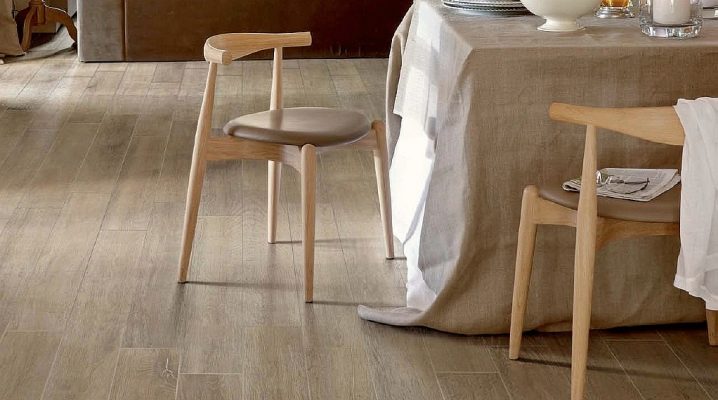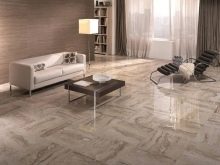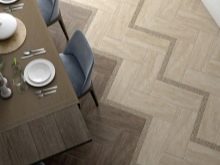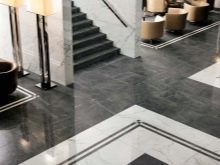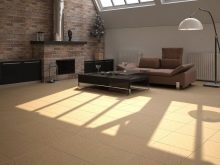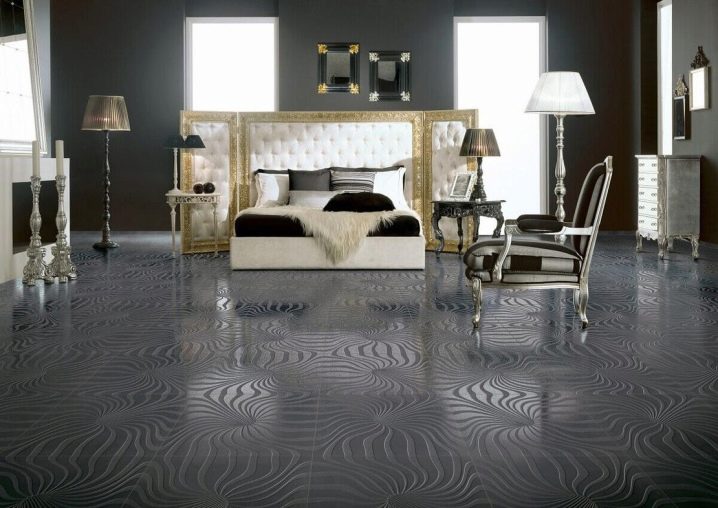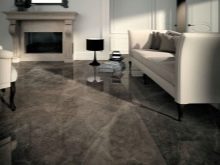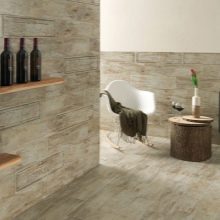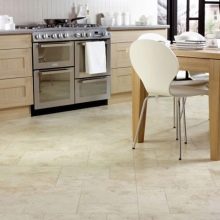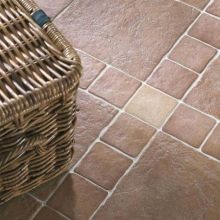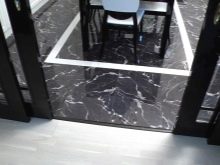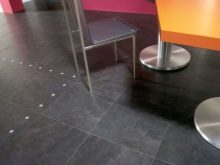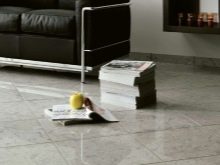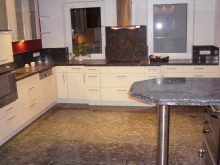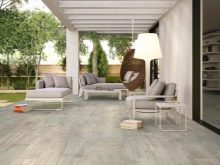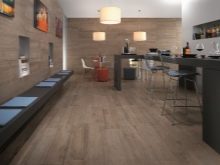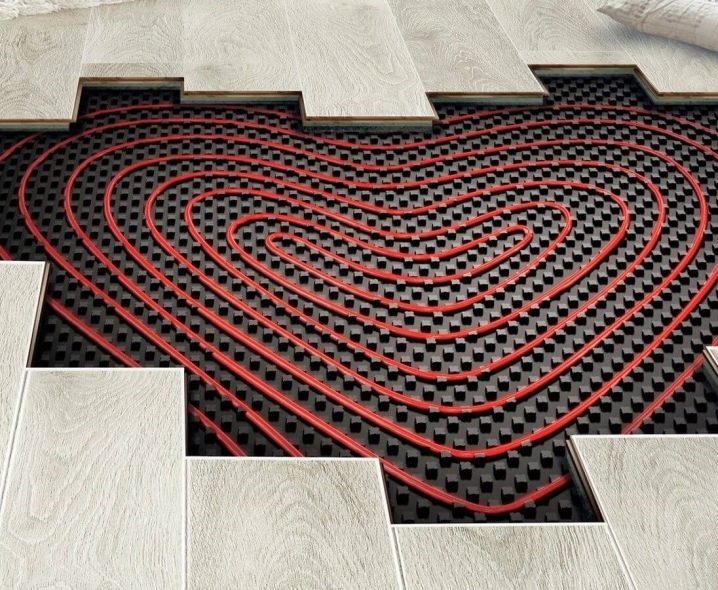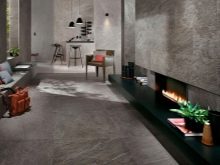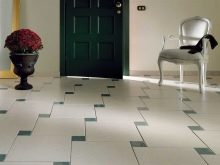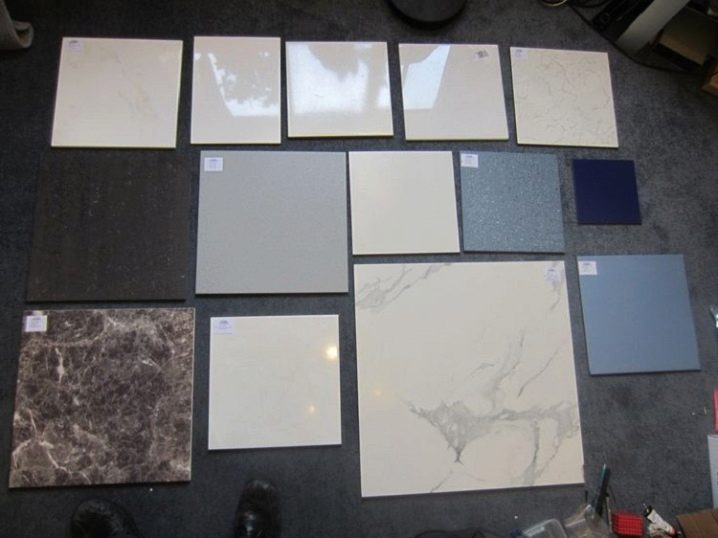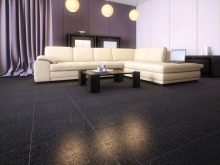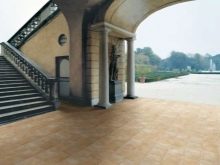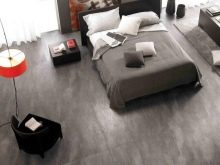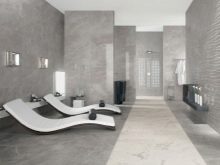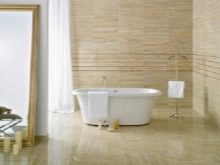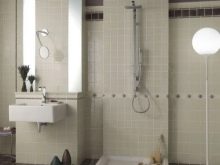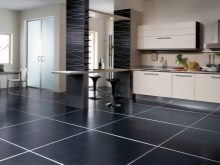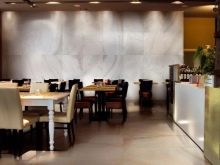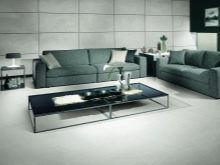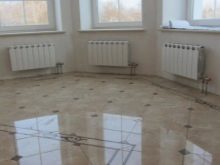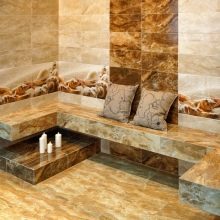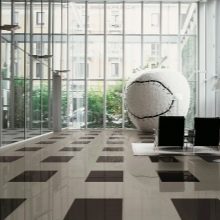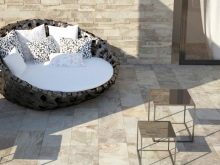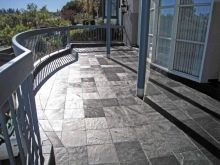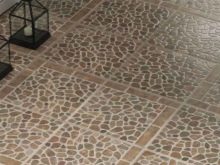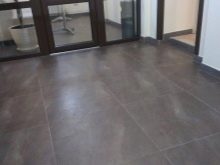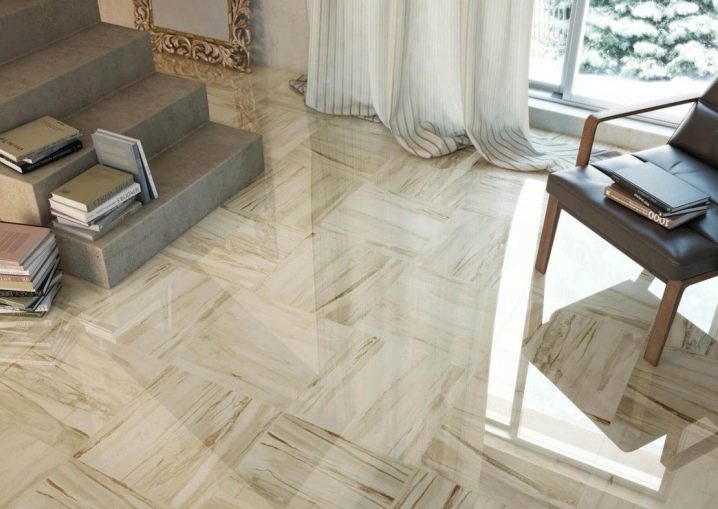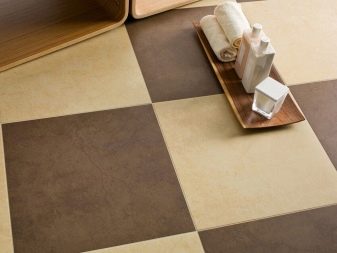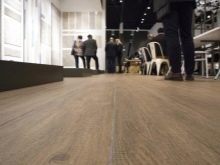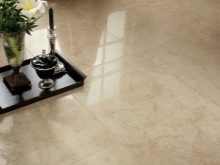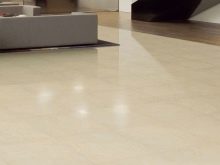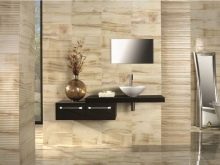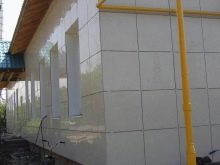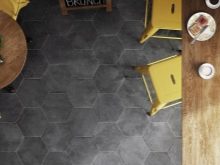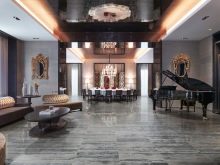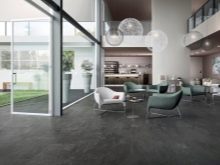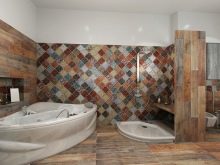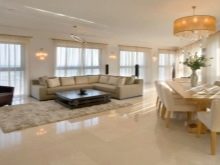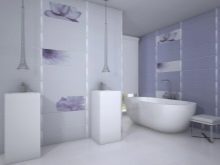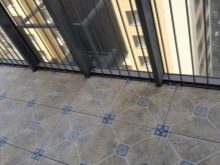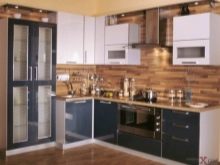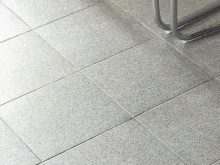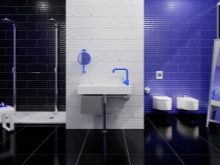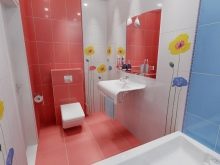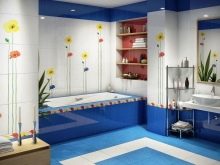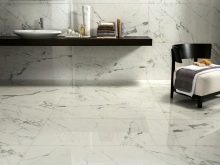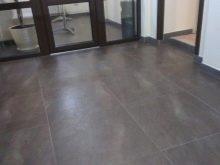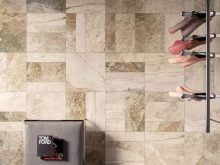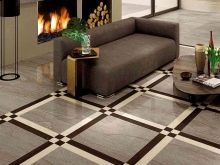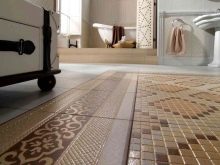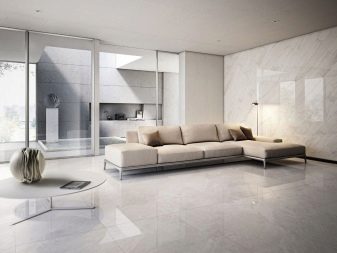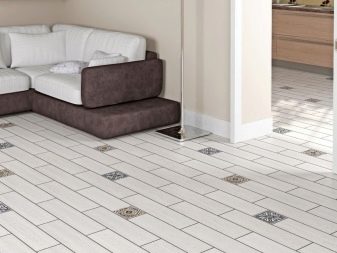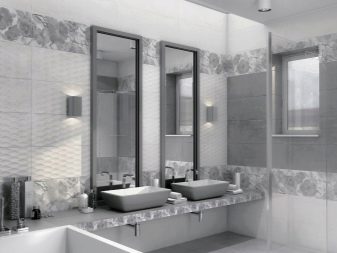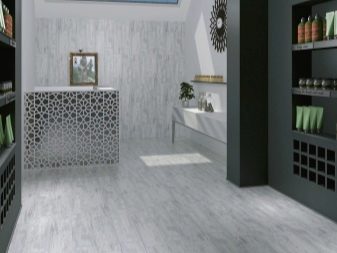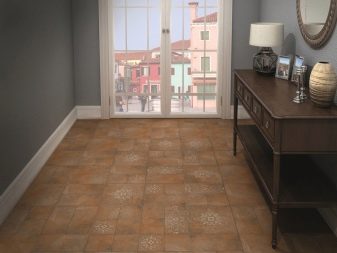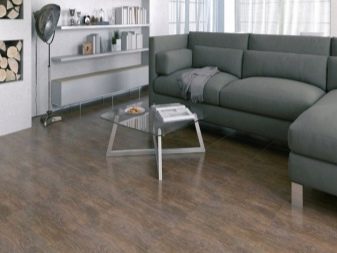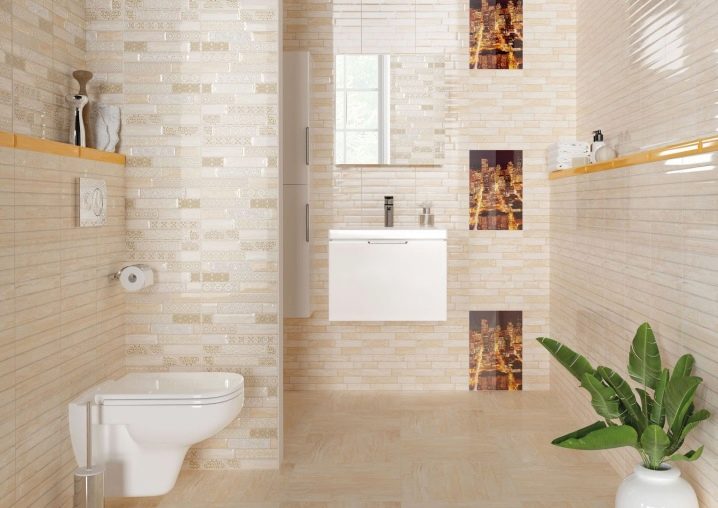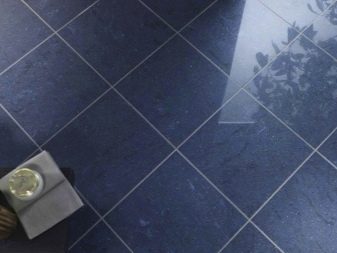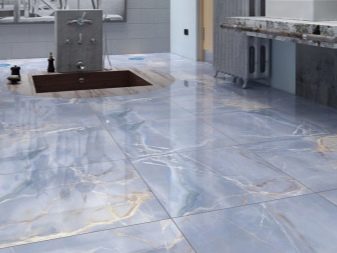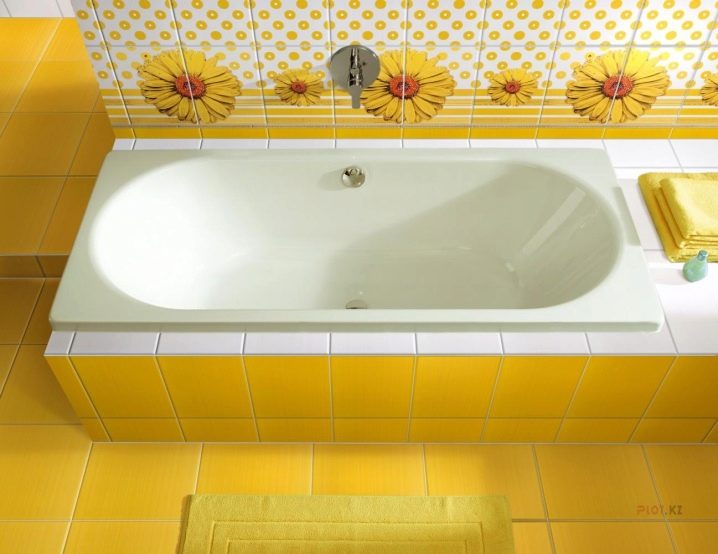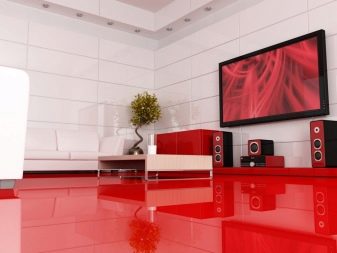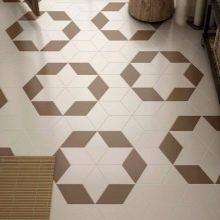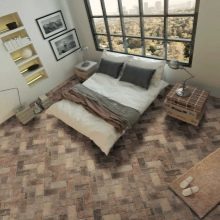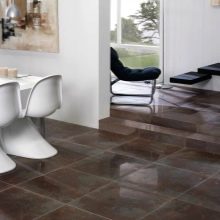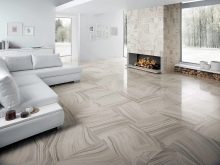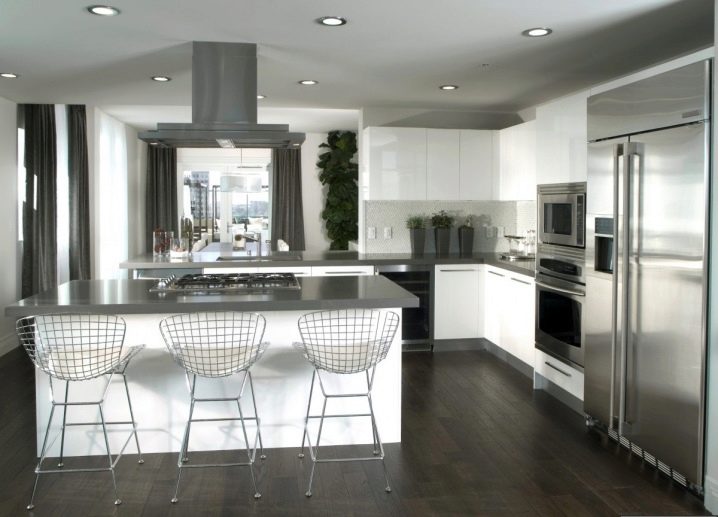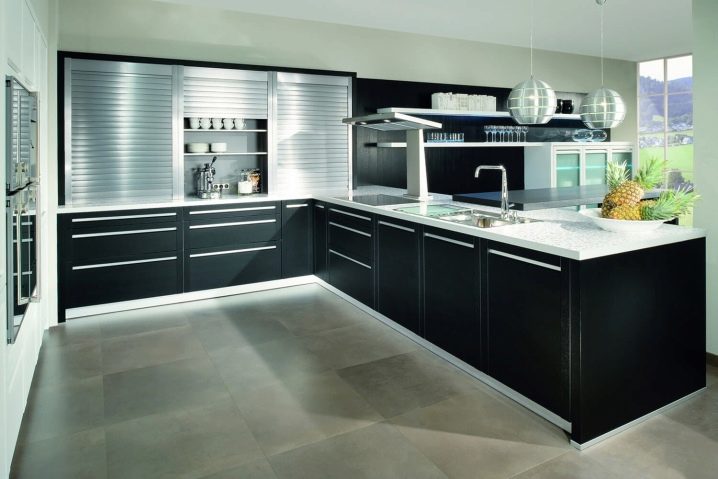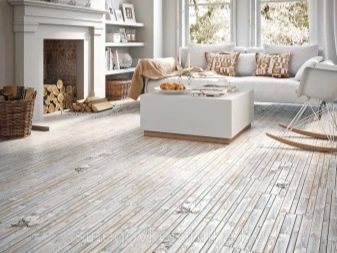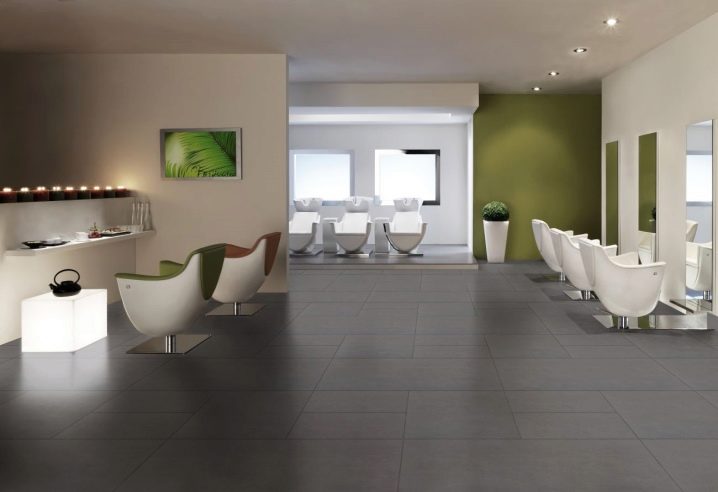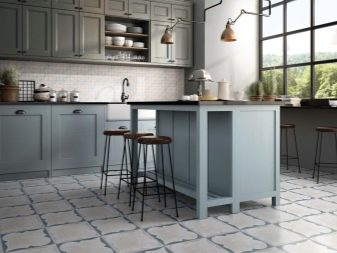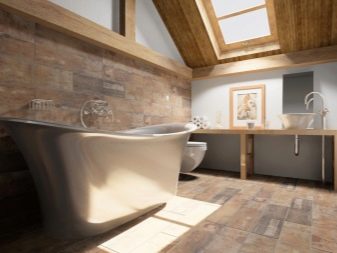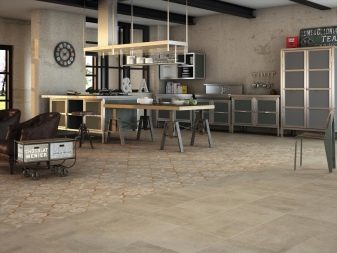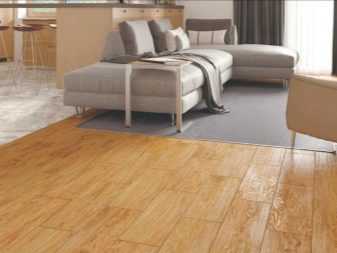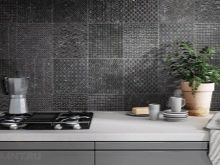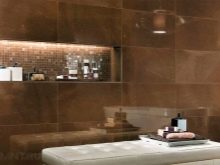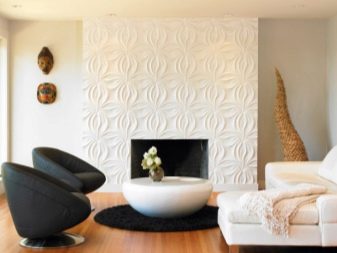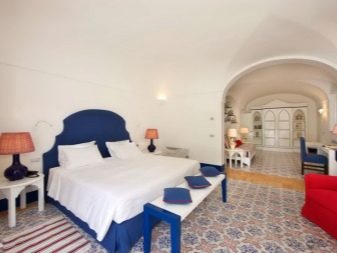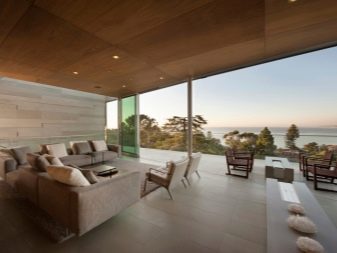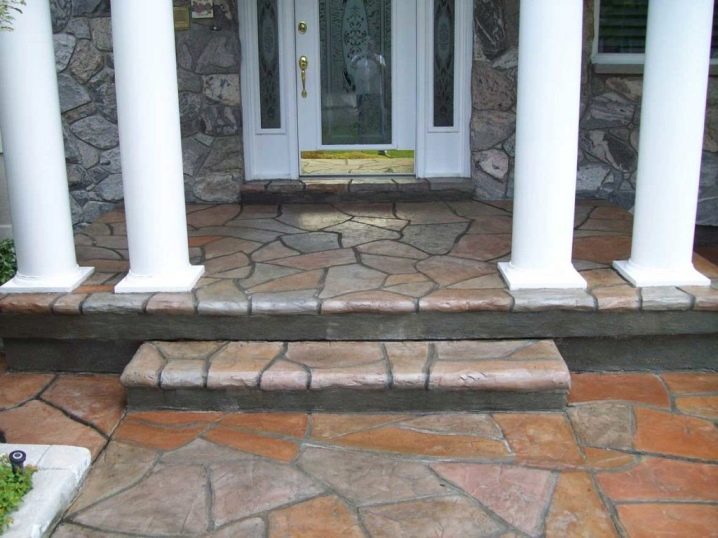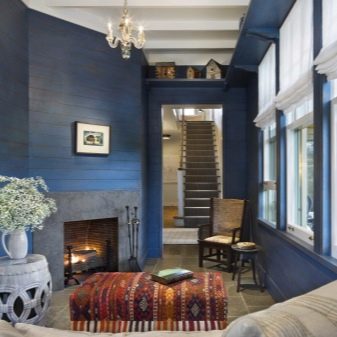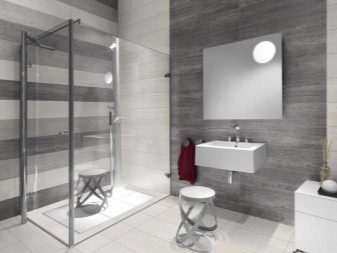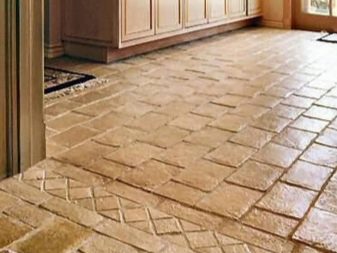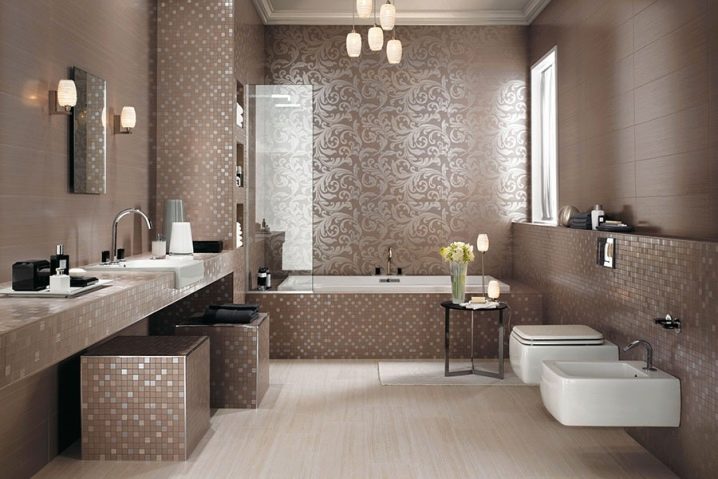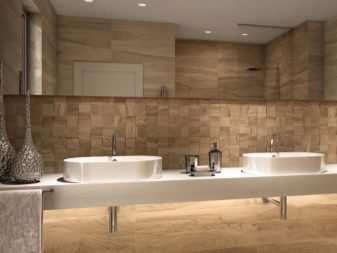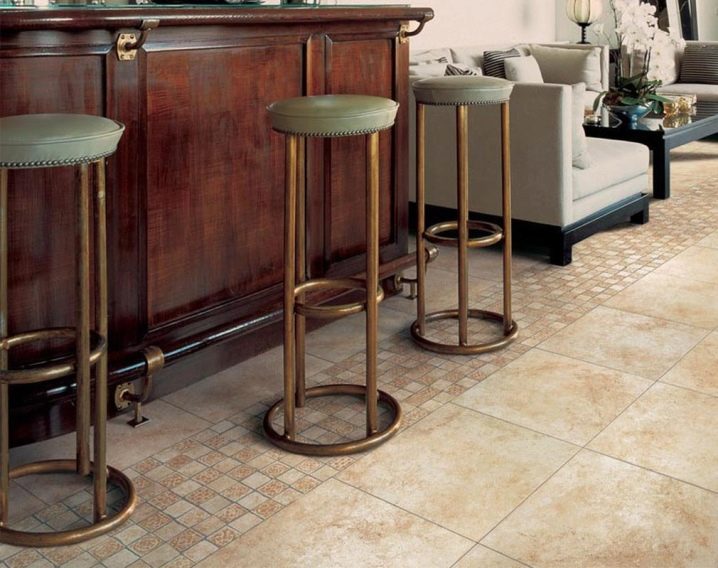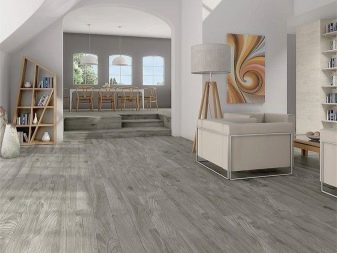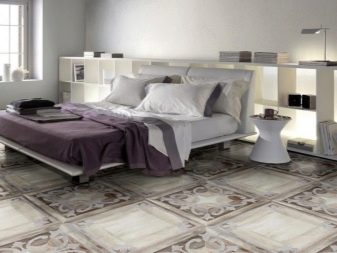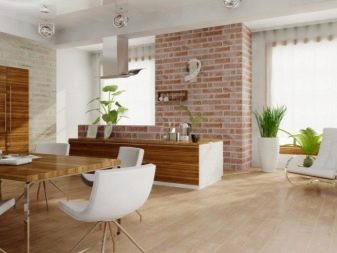Porcelain tiles: types and properties
The modern building materials market has recently added a new type of tile - porcelain stoneware. Initially it was intended to be used only for technical purposes as a floor covering with heavy loads. However, thanks to the development of technology today, porcelain tile has firmly taken its place among the facing materials between natural stone and ceramics.
What it is?
Porcelain tile is of artificial origin, which does not prevent it from surpassing natural stone, such as granite or marble, in some technical characteristics.
The difference with ceramic tiles is also obvious. The tile represents the burned clay covered with a layer of enamel,whereas porcelain stoneware is a product of the most powerful high-temperature pressing of a mixture of kalinic clay, feldspar, quartz sand and other components. Production of porcelain stoneware is carried out at temperatures up to 1300 degrees. The powder mixture melts, and then is pressed to such an extent that eventually the material acquires a monolithic structure without microcracks and pores. In addition, colorings are immediately added to the mixture, which makes it possible to obtain a uniform color throughout the structure of the material.
It differs from granite and clinker. Clinker tiles are produced by extrusion or wet molding from refractory clays.
The material has no lime impurities, which allows to preserve color for many years.
Specifications and properties
The popularity of porcelain stoneware provides a number of its positive qualities. It is durable, durable, not subject to abrasion and mechanical damage in the form of scratches and dents. In addition, porcelain stoneware products have a high degree of moisture resistance and are not susceptible to destruction when temperature drops.
Weight
Porcelain stoneware weight is an indicator used for calculating costs during construction. Weight depends on the purpose of the facing material.So, the wall tile will be easier floor, therefore at purchase of glue it is necessary to consider it.
The specific gravity is 2400 kg per 1 m3. When determining the value per 1 m2, they are repelled by the size of the tile and its thickness. For example, with a thickness of 12 mm and a size of 300x300, the weight will be about 24 kg.
Density
Most often, the density of porcelain tiles reaches 1400 kg / m3. Tiles of different sizes are slightly different from each other. High density provides excellent performance, but the weight will be great.
When choosing porcelain stoneware products, you need to find out if the floors in your home can withstand them.
Wear resistance class
This indicator determines the service life of products. According to the European standard EN 154 and GOST, porcelain stoneware products must be subjected to strength tests before sale with the use of special roller equipment. There are 5 main classes from PEI 1 to PEI 5.
Thermal conductivity
This property of porcelain tile depends on several factors: porosity, composition and degree of crystallization. Due to the low thermal conductivity, the material is used for cladding facades and interior walls of residential buildings.This high-tech coating has proven itself as a floor covering, especially when laying the “warm floor” system.
The size
The nominal dimensions are: length from 200 to 1200 mm, width from 300 to 1200 mm, thickness not less than 7 mm (according to GOST). Popular sizes of porcelain stoneware among consumers are 30x30, 40x40 and 60x60 cm. The thickness of this finishing material varies from 7 to 30 mm. The degree of abrasion of the coating depends on it.
Today, manufacturers offer a wide range of products in various formats. The size of ceramic granite slabs depends on the purpose and parameters of the room. Thus, wide-format porcelain tiles with dimensions of 90x90 and 120x120 cm and more are used for large areas, are convenient for installation, and allow reducing the number of joints.
Thanks to the latest innovative solutions, thin ceramic-granite sheet material - curlite, which with large sizes has a small thickness of 3 to 5 mm, was developed. Because of its flexibility and durability, the range of application of this material is very wide. They are faced with walls, doors, bar counters, columns, furniture and any other surfaces of various forms.
Composition
The production of porcelain stoneware products is based on the production of special porridge mass - this is slip, which of the following components:
- Coaline clay gives refractory properties and binding ability;
- illite clays are required for flexibility and flexural strength;
- quartz sand contributes hardness;
- Feldspar gives high resistance to chemicals.
In the future, from the slip get a powder mixture, which is injected mineral additives and dyes.
Water absorption
This is an index characterizing the degree of moisture resistance of materials. Since the structure of porcelain stoneware is monolithic, it has the lowest index from 0.01 to 0.05%. For comparison: ceramic tile has 1%, and marble 0.11%.
High moisture resistance and frost resistance allow using ceramic granite for finishing shower and bathrooms, as well as revetting external walls in cold climates.
Advantages and disadvantages
The advantages of porcelain tiles include:
- resistance to the effects of drugs based on acids and alkalis;
- high durability to blows and bends;
- frost resistance;
- resistance to sudden temperature changes;
- durability;
- fire safety;
- environmental friendliness;
- resistance to light, does not fade and does not fade;
- uniform color and pattern throughout the depth;
- the possibility of obtaining products with anti-slip surface.
Disadvantages:
- fragility during transport;
- difficulties arising from the processing, cutting and drilling of porcelain stoneware;
- considerable weight;
- high cost, especially in comparison with ceramics.
Kinds
Porcelain tiles can be classified according to several criteria.
According to the method of manufacture
According to the production method, the following types of porcelain stoneware differ:
- Technical - This is a simple and cheap option. It is characterized by high strength and low degree of abrasion, but unsightly design. It is used for finishing technical and utility rooms that do not require exquisite design.
- Homogeneous the material is painted uniformly throughout the volume and is the standard of production for conventional technology.
- Glazed or smaltized porcelain stoneware is a material obtained by standard technology followed by firing of the glaze applied on top.
When smaltirovaniya used double extrusion, when the vitreous enamel is pressed on a previously obtained basis.In all cases, this top layer has a low resistance to abrasion, so with intensive use loses its decorative effect. However, the lifetime is higher than that of ceramic tiles. Experts do not recommend stacking such products in public places.
Double backfill is a method that is fundamentally different from glazed in that in this case the top layer with a thickness of 3 mm has the same characteristics as the tile itself.
Double pressing is also used in the production of porcelain stoneware.in which the necessary colorant is added to the second layer. Both layers have all the technical properties of porcelain stoneware (including the wear resistance coefficient), so these plates are used in rooms with high traffic. The application of this method is also advisable for obtaining rich bright and rare colors.
To make the products frost-resistant at the production stage, special additives are added to the mixture, due to which the plates have increased strength and wear resistance.
As a rule, such frost-resistant materials are used for facades and house adjoining territories; therefore, in addition, their surface is made corrugated, non-slip.
By type of surface
Matte tiles are not subjected to additional processing after pressing. This material has high strength. Unpolished porcelain stoneware difficult to spoil, scratch, hit.
Due to the rough surface, such coatings like to use in garages and car repair shops, car washes, warehouses and other technical premises. The only drawback noted by consumers is the formation of stains on such ceramic granite due to the absence of the upper protective layer.
Polished Porcelain stoneware is produced by abrasive surface treatment of a matte product. Glossy finish looks great as a finish in high-end institutions. It should be remembered that polishing makes the floor slippery. Over time, the specularity wears off, and the product becomes matte again. Since microcracks can form during the polishing process, after removing the top layer, the moisture resistance and strength of the material decrease. Experts recommend rubbing such plates with special wax.
Polished or satin finish The material belongs to the decorative, because it has an unusual velvety matte surface.To produce it, mineral salts are added to the top layer during production. Decorative coating can not withstand heavy loads and intensive use, so it is better to use it for finishing residential premises.
Structured porcelain stoneware has a relief structure, therefore it is a non-slip material. Such plates can imitate wood, brick, marble, leather, fabric. Production methods differ only in the processing of the upper decorative layer. Having a clear originality of aesthetic advantages, these products have good technological characteristics inherent in porcelain stoneware.
There is also a high-tech lappatirovanny porcelain stoneware. The surface treatment technology developed by the Italians. The canvas is polished in such a way that it acquires a combined texture: half matte, half polished. The process takes less time, unlike polishing, and ends at the moment when the tile takes the form of unfinished polishing. Since the processing cuts a small amount of material, lappatirovanny porcelain slightly loses durability.It can be used in the design of common areas.
Rectified porcelain stoneware looks no less interesting. As a rule, at the exit from the furnace, the plates have geometrical microscopic flakes. Rectification is the cutting of edges with the help of laser machines or with a thin stream of water and abrasive. The result is a porcelain stoneware, which can be laid almost seamlessly. Of course, this increases the aesthetic perception of the coating.
Experts do not recommend using seamless material in rooms with sharp temperature changes and in places with heated floors, since the lack of seams causes damage to the plates.
Anti-slip porcelain stoneware can be made by any of the above. As a rule, products with a matte, structured or lappatirovanny surface are referred to coatings without a sliding effect.
By purpose
Porcelain tile is used to finish the following surfaces:
- For the floor. Floor plates are popular when decorating public spaces. These include schools, hospitals, hotels, libraries, museums, shopping, entertainment centers and offices.
- For walls. The latest technology allows you to decorate with the help of porcelain stoneware walls of any design.
- Facade plates - the most popular materials. They are great for decoration ventilated facades.
By design method
Wall and floor decoration is usually chosen for a specific interior. Modern finishing materials allow you to implement any design ideas.
- Panel of porcelain tiles on the floor can replace the carpet. This coating not only looks amazing, but is also convenient, practical and durable. The panel will give the interior a unique style and originality.
- Mosaic differs in high durability due to the small sizes of a tile. In addition, the miniature gives room for creativity. With the help of such elements you can create drawings, ornaments and interesting patterns.
- Corner, many-sided, separating friezes and bricks also look spectacular in many styles of interior.
Application
Porcelain is in great demand and is used in many areas related to repair and finishing works.
Most often, porcelain stoneware products are used for exterior decoration.The main quality of this material in this case is frost resistance, moisture resistance and resistance to temperature differences.
Porcelain tiles can be used for:
- Facing houses and facades;
- finishing of open terraces, paths and stairs;
- facing the pools in the open.
For the interior decoration of private homes, porcelain stoneware is often used as a floor or wall covering. Due to the technical characteristics, this material is almost indispensable for finishing the floor in public places with a maximum cross. Metro, hotels, train stations, airports, hotels and trading halls, as a rule, are finished with ceramic granite slabs.
Wall panels gained popularity due to the appearance of wide-format porcelain stoneware. Designers use it to design status institutions: banks, reception rooms, exhibition halls.
Porcelain tile is perfect for restoration finishing work. Due to their resistance to water and chemicals, they are lined with car washes and workshops, chemical laboratories and garages. To do this, often use the usual matte material without additional decorative finishes.
A curb is used to move from porcelain stoneware to walls lined with other materials.
In the apartment porcelain tile also finds a place for itself:
- The floor in the hallway, trimmed with artificial stone, transforms the corridor and gives it presentability. For rooms that come in outdoor shoes, the best option would be a tile with a high abrasion coefficient (4 and 5 classes). An important factor is the corrugated surface, because it will prevent visitors from slipping in wet or snowy weather.
- Floor covering in the living room of any size will look elegant. The main thing is to correctly choose the color scheme, pattern and texture.
- Even in the bedroom, you can use porcelain, for example, satin. Its velvety, soft and warm texture will allow walking barefoot on the floor.
- For the decoration of the walls and the floor in the bathroom or a shower, plates made of structured or lappated porcelain stoneware are perfect. Here it is important that the surface is non-slip and as waterproof as possible.
- Sink and bath can also be finished with artificial stone. Should rememberthat in this case it will constantly be in contact with shampoos, creams, washing powder, bleach and other household chemicals, therefore it is better to opt for plates with a high degree of resistance to chemicals that have a structure with a small number of pores. At the junction of the walls and the floor is better to install porcelain or ceramic plinth.
- Balcony, loggia or window sill in the apartment can be perfectly decorated with the help of ceramic granite products.
- Porcelain stoneware works best for the floor in the kitchen, since it is not subjected to mechanical stress, such as scratches from the legs of a table or chairs. Resistance to bending allows you to resist heavy cabinets. Shock resistance will protect the floor from dropping any heavy objects (from the pan to the heavy chair). Frequent cleaning and washing will not erase the pattern.
- Recently, cases of design artificial stone countertops, which increases its durability. The kitchen is characterized by tiling the area near the cooking surfaces. Similarly, fire safety and thermal protection of the space is ensured.
Colors
Ceramic granite products are diverse not only in texture and shape, but also in color, which allows you to create original compositions for the design of the floor, walls and facades. By drawing and color distinguish the following types.
Salt pepper
This option is a uniform color with black and white patches evenly spaced throughout the structure. This is the cheapest option for staining porcelain, because it is simple to perform. The colors can have a light beige or gray color, demanded for public spaces: cafes, canteens and offices, as it looks aesthetic and unpretentious. If you choose a dark shade, polish the surface and add decoration with a patterned border, you can get a more elegant option suitable for halls and living rooms.
Monocolor
It is a single color with minimal grain. When dyeing at the production stage, dyes with metal salts, for example cobalt or zirconium, are added to the mixture. Monocolor is obtained by a homogeneous, glazed method or a double backfill method. It is divided into two types.
- Achromatic colors represented by shades of white, gray and black.Also this category includes silver, graphite and milky shades.
- Chromatic shades - all other colors. Rare bright shades, such as green, blue, red, yellow, or orange, are produced by the double backfill method. Since this method involves double pressing, the technical characteristics of porcelain stoneware do not suffer.
Natural stone
This is the most complex color, imitating the color of natural stones:
- Marble is a classic solution. Porcelain tiles accurately reproduce the color richness of shades, play, streaks and the inclusion of natural stone. To give depth and saturation of the color surface lappatiruyut or polished.
- Under the granite.
- Under the shell rock.
Textural
Such porcelain tile is different from other types of complex patterns and various textures from imitation of leather and fabric to wood. In this case, the focus is on tactile and visual sensations, so the color is usually monophonic, dull, muted pastel colors: blue, pink, beige, coffee.
When choosing a color it is necessary to take into account the tone, brilliance and its uniformity.
White
Experts caution: dazzling white tile is tiring. For a comfortable perception, whiteness indicator should not exceed 72%. It should be noted that porcelain stoneware is not perfectly white, since no dye is able to completely rid the mixture of the shade of the raw material - kalinic clay. The lightest are in ivory or baked milk.
Designers use such plates as flooring.to visually enlarge the room. It is advised not to combine it with the patterned walls of dark tones, since spatial perception will be distorted. White color can merge and separate other shades. It is universal. Particularly popular white color in the interior design in the style of techno and loft.
Gray
The gray color of the ceramic granite is white and black. This is a neutral color, which does not contribute to emotional intensity, does not create individual images, but is indispensable as a background. It is used for any interiors.
Designers do not recommend using gray with white ceramic granite, as it visually reduces whiteness.
The black
This is an aggressive color that is capable of suppressing psychologically with excess. It looks in combination with any shades. It is most advantageously combined with white, gray and bright colors. Pastel and calm tones in a frame of black color look faded.
Since the carbon color visually reduces the space, you should take this into account when creating the interior. Black emphasizes and reveals any dirt, dust, traces of drips and fingerprints, so its use in the kitchen entails frequent cleaning. Polished black kermogranit looks smarter than matte, because of which the latter version is often used for decoration of the reception and ceremonial halls.
Brown
This color has a lot of shades. Each manufacturer has its own brown gamma. As a rule, it coincides with the shades of wood, because granite "under the tree" - one of the most popular options.
Recently, wenge color has come into fashion. However, designers are advised not to overload the space of the room with dark tones, since they visually narrow the room. It is better to use them for zoning area or highlighting interior details.
The chocolate shade is wonderfully combined with neutral and warm tones: cream, golden, pink, blue.
Beige and sand
These colors are inherently included in the color range of the previous color. But because of their extraordinary popularity stand out from the general palette. They are neutral and relevant in any combination. Such paints are especially in demand for the design of office space and other public spaces.
Blue
This is a rare color, obtained by adding an expensive inorganic dye to the mixture, which increases its cost. All shades of blue are cold, allowing to visually expand the boundaries.
Blue does not attract attention, and this quality allows it to be used in work areas. More saturated colors: turquoise or sapphire are independent, therefore they are able to accentuate the areas they have decorated.
Yellow
It is a warm, sunny and cheerful color. It illuminates the interior and is used quite often.
Designers divide it into 3 categories:
- Light yellow - comfortable, peaceful.
- Bright yellow (for example, lemon).In large volume it tires, therefore it is recommended to combine it with other shades.
- Sunny, golden and orange - joyful tones, also requiring a combined approach.
Red
This color is very active and aggressive. However, its effect depends on the shade. Exquisite burgundy color looks gorgeous and self-sufficient.
Bright red must be combined with a less aggressive shade. Bright and bold red color scheme is suitable for interiors in the style of art deco or avant-garde. It is practical because it hides stains and dust.
Design
A wide range of stoneware products allows designers to develop truly unique interiors.
- Thus, the decor of the floor in the form of a mosaic or an oriental ornament will become a real work of art, emphasize the sophistication of the interior and become an original design element.
- Patterns in the form of a carpet on the floor (with a modern and ancient pattern) will make the room beautiful, picturesque and solemn.
- Embossed porcelain with imitation of brick, concrete or stone will give naturalness to the interior, bring natural motifs.
- Satin matte material will create a feeling of softness and velvetiness, comfort and warmth.Tactile susceptibility - an important factor in the arrangement of the interior.
- Give the room a shine and luxury can porcelain with the texture of polished marble. Hall or living room with such a floor will greatly benefit.
- The glossy appearance of the floor always introduces elements of exquisite gloss to the interior. And if the plates will imitate onyx, then more wealth and chic.
- Ceramic granite floor "under the oak" looks expensive, but it is practical to care. This floor will be appropriate in the hallway or dining room.
- Corrugated stoneware for slate, sandstone, concrete or plaster is a great solution for industrial and Scandinavian styles in the interior.
- Smalted and unglazed materials are advised to combine. Best of all this combination looks on the walls.
- Experienced designers use the layout of porcelain tiles "with inserts." In this case, the laying implies an offset to insert the form of an additional element that is different from the base material. The decor can be metallic, patterned or monophonic.
Styles
When choosing a ceramic granite tile, one should pay attention not only to its technical properties, but also to the general concept of interior stylistics.
High tech
The cutting-edge hi-tech style basically has minimalism and solidity. He has the laws of geometry and pragmatism. The style is suitable for those who do not accept the oversaturation of the interior with unnecessary objects, being a supporter of brevity and mobility. Since the design implies the use of high-tech materials and structures, the cost price characterizes it as one of the expensive styles not available to everyone.
The color scheme is high-tech monochrome, there is no riot of colors in it. As a rule, they use strict and classic colors (black, white and gray). As an accent, designers apply different neon shades: green, blue or purple.
It is better to choose ceramic granite for interior decoration “under the metal” or “under the stone”. The most suitable option is floor and wall panels without relief. For example, for floor designers recommend the use of plates with a matte surface. Firstly, they are anti-slip, and secondly, they are more resistant to mechanical damage, so they can be laid on the entrance areas, as well as in areas with high traffic: in the kitchen, corridor, office.
Large monolithic surfaces are relevant for this style.therefore, porcelain stoneware can be used on large areas. This method allows to reduce the cost of repairs, because the grout for the joints will need to a lesser extent.
In the design there are transparent or chrome furniture, various lighting, and including the use of point and linear lamps. In this regard, you should not be afraid of dull gray scale. Properly selected metal parts, lamps and glass will create a subtle geometric play of light and shadow.
Designers warn that nothing should distract the eye from the material and form, therefore, in this case, porcelain stoneware without patterns and drawings is used. The best solution for the walls will be rectangular or square plates, polished to a mirror finish. As a rule, they are monochromatic, but as an alternative they offer a two-color version or a mosaic tile with a metallic tint.
Monochrome imitation of marble or granite is perfect for the floor.
Loft
This is a modern trend in interior design, implying imitation of industrial spaces.
The following materials are usually used as a background:
- brick, which is the basis of the loft style and its unchanged attribute;
- concrete - a wonderful neutral background for any decisions;
- metal in the form of steel sheets, aged copper, bronze or brass elements;
- plaster also allows the background to “not interfere” with the embodiment of other design ideas;
- Stone is also suitable (quartzite, sandstone or chaotic natural stone masonry are most popular).
Structured porcelain tile will successfully replace all the listed options.
Wooden surfaces are designed to soften the harsh nature of the loft style. However, it is not always possible to use wood due to the peculiarities of the rooms, for example, in rooms with high humidity. In this case, wooden plates can be replaced with porcelain stoneware products with a finely worked-out texture of old wood.
Porcelain tile will allow the room to keep the original appearance for many years.and a wide range of offered colors, textures and sizes make it possible to achieve excellent results in interior design, giving it at the same time brutality, cleanliness and comfort.The color range is usually gray-white-black. Also characteristic are the colors of old bricks, light beige colors.
Since the main criterion of style is the presence of a large open space, designers often use wide-format stoneware plates. Often used matte, slightly worn surfaces.
Creating a rustic French interior requires the use of muted pastel colors. It is characterized by natural shades and natural materials.
In this case, designers recommend for finishing porcelain tiles in the following colors:
- Ivory;
- pearl white;
- silver;
- beige or cream;
- olive;
- lactic;
- soft pink or blue;
- jade;
- pale lilac;
- lavender;
- terracotta;
- dark sandy.
Such a scale creates a pacifying mood and a comfortable atmosphere.
The style is characterized by the absence of bright flashy shades. The accent may be a refined ornament, for example, floral. Stripes, cells or waves are often used for decoration.
Decorators do not recommend using glossy stoneware tiles for laying on the floor or walls.It is better to give preference to rough matte surfaces that mimic natural materials. The shape of floor tiles is usually square or rectangular, less often a polyhedron.
Porcelain in the style of "Provence" can be found in any room, but more often in the kitchen, bathroom or on the terrace.
Other styles
Porcelain tile looks great in any interior style. In addition, an added bonus is its strength and durability. The modern market offers the broadest choice not only in terms of color, but also in the matter of texture solutions.
Porcelain tiles can look like slab tiles or Italian mosaic. They can replace oriental carpets in their performance or become the main decoration of a classical hall in the English manner.
Designers freely use porcelain stoneware elements of small sizes to get patchwork coverings in the form of a patchwork floor stained glass window.
Styling options
The modern market of finishing materials offers a large selection of porcelain tiles, which vary in size and shape. This is due to the variety of styling options.
Layout for the floor
- The standard way is a seam in the seam. Most beneficial when using square and rectangular plates.
- Scramble. The joints of the plates are moved half in relation to each other, which allows you to hide minor defects. The method is suitable for laying porcelain tile in the kitchen or in the hallway.
- The diagonal layout visually expands the room, but is more complex in execution. Experts recommend the use of small plates.
- The installation of "herringbone" reminds laying parquet. To implement it, it is better to choose rectangular elements.
- Chess layout is obtained by applying contrasting plates. At the same time they can be laid using a standard method, a diamond or diagonally.
- Carpet (mosaic) - consists of small elements of different colors. So, laid out ornamental composition, reminiscent of a carpet.
- Kaleidoscope - similar to the mosaic layout, but uses no more than 2-3 shades. The pattern can be horizontal, diagonal or chaotic.
It is interesting to look at various combinations of porcelain tiles of different sizes or textures. It is important to take into account that light shades visually expand the space,but if large elements are used on a small area, the room will be visually reduced.
Layout for walls
- Base - seam in the seam.
- Stripes - a universal method, where the remaining trimming and small parts are used for curbing and separation of spaces.
- Mosaic or ornament, when a panel or a repeating motif is laid out from small details.
- Brick imitates bricklaying.
- Chaotic repeats pattern of a stone wall.
Producing countries and brands
The modern market of finishing materials offers a wide range of ceramic-granite products. Among them are both well-known brands with a high rating and little-known firms of small scale. The highest quality products are Italian masters who are the creators of porcelain. However, the Spanish, Chinese and Russian brands are not far behind them.
Italy
The most popular Italian brands:
- Italgraniti. The Italian brand produces materials for interior and exterior living spaces.
- Mariner. The products have an unusual texture, imitating natural materials. A large variety of textures, patterns and decor pleases fans of both the classics and the ultra-modern styles. The most popular facing of stairs, floors and facades.
- Refin - a brand that produces elegant and sophisticated collections with various patterns and ornaments to embody any design ideas.
- Laminam - one of the few brands that produces unique widescreen porcelain tiles with dimensions of 1x3 meters and a thickness of 3 mm. The material has elasticity, so it can be laid on wavy surfaces.
Spain
Venice, located on the water, is a city of canals and embankments, a characteristic feature of which is their coverage. Therefore, many Italian collections tend to imitate the natural stone of the Venetian embankment.
Spanish manufacturers, as well as Italian, are the leaders in sales of porcelain stoneware. Factory Alaplana Fresno was founded in the Spanish province of Castilla in 1957. Highly artistic design, perfect quality, a wide range of products from country to classics and the use of technological innovations have made the company a successful competitor among the leading Spanish manufacturers. The most famous collection called AlaplanaFresno is a floor ceramic granite.
There are several other Spanish porcelain stoneware factories worth mentioning: A. C.A Ceramicas, AbsolutKeramika, Aparici, Aranda, Azulev.
Manufacturers from other countries
Lasselsberger is a European holding for the production of ceramic tiles and porcelain tiles, with factories located in more than 10 countries, for example, in Russia, the Czech Republic, Romania and Hungary. Each company is focused on a single region and takes into account the demand of specific consumers. As a rule, the style of porcelain stoneware products is discreet, designed for public spaces, decorated with exquisite taste.
Turkey produces ceramic granite in traditional white and blue colors., with the lack of natural and animalistic patterns. The most famous brands are VitrAArkitekt, SeranitSeramikSanatiyi A, Kaleseramik.
Chinese stoneware
Chinese firms compete successfully in the market with European products. You can highlight the most famous: SuperGlass uTangCeramics.
CIS
Ceramic granite products have recently been produced in some CIS countries. For example, the Kiev factory Atem began production with ceramic tiles, but its products gained the most popularity when they launched a line for the production of porcelain stoneware. The size range includes plates 300x300, 400x400, 600x600 and 600x1200 mm. All collections are the embodiment of the latest trends in the world of interior design, since Italian and Spanish designers are involved in the development of the style of each of them.In addition, the company's products have good performance.
Belarusian brand "Keramin" - the largest enterprise in Europewhich produces material on Italian equipment from Sacmi. Every year the plant updates its product range in collaboration with the Center for Modern Design. The collections contain porcelain tiles with a different texture: stone, wood, fabric. Also, this manufacturer produces curbs, baseboards, inlays, mosaics, floor panels. The basis is natural and artificial raw materials. The technology allows to obtain glazed and unglazed stoneware.
Russia
Russian raw materials for artificial stone makes products more accessible than European analogues. The production process is possible only in large enterprises, which contributes to lower prices due to volumes, expansion of the range and quality control at all stages.
Since 2001, the company Estima, known on the market of finishing materials, has been producing about 10 million square meters of floor coverings characterized by a variety of textures and colors.Feldspar from the Urals, Ukrainian white clay and dyes from Italy are used as raw materials for the base.
Products brand Kerranova manufactured at the plant "SamaraStroyfarfor" since 2004. The brand makes high-quality porcelain stoneware using digital printing for drawing a picture. The most expensive options are imitations of marble, onyx, slate and some types of wood. Digital technologies not only made it possible to reduce the percentage of defective products, but also made it possible to create new designs in a short time.
Care
Despite the fact that ceramic-granite products withstand any negative impact, their appearance needs care. It should be noted that the material itself is not afraid of dirt, but the inter-tile joints are sensitive to contamination and are destroyed under intensive exposure.
Care instructions when installing:
- In order to preserve polishing, in the process of laying it is recommended to close the plates with a protective coating.
- Before using painted grout, it is better to treat the polished surface with a stain-resistant preparation that will protect the top layer from staining during the processing of the joints.
- For the first time, the floor stoneware coating is cleaned immediately after installation. It should be remembered that extraneous compositions should not fall into the joints. Wash off the primer, putty and lime, cement will help funds based on hydrochloric acid.
Recommendations for care during operation
- For cleaning ceramic granite products it is better to use a mild and liquid detergent.
- Cleaners should not contain acid, as it corrodes the connecting seams.
- To protect against scratches and other damage, experts advise rubbing porcelain tiles with wax-based products.
- When caring for polished surfaces, you should promptly remove dirt and sand from the floor, which are strong abrasives.
- To protect floors from stains, they should be treated with water repellent once a year (minimum). First of all, this concerns polished porcelain stoneware, since the upper layer is removed during polishing and micropores are exposed. If dirt gets into them, then it is very difficult to get it out.
- In rooms with a high probability of various contaminants, such as the kitchen or hallway, it is better to stack matte porcelain stoneware.Such material can be easily cleaned, it is less noticeable dirty marks and scratches.
- Structured porcelain stoneware non-staining, it is easy to wash, in addition, its surface is usually non-slip. That is why it is appropriate in bathrooms, toilets, changing rooms and near the pools.
- Stains from tea, coffee, fruit juice, blood, wine and ice cream are removed with a weak solution of baking soda or detergent based on alkali, for example, chlorine. The latter option is best used only in the case of dried spots.
- Traces of tile adhesive, wax, resin, paint, technical oil, rubber or nail polish are removed with acetone or gasoline.
- Acid-containing preparations will help to wash away rusty or ink stains.
Beautiful examples in the interior
It is easy to integrate an artificial stone into any interiors.
- For example, gray porcelain under a whitish tree will make the room more aesthetic.
- Imitation of a natural stone will give elegance.
- Matte satin or unpolished surface is pleasant to the touch, so this ceramic granite is appropriate in bedrooms and bathrooms.
- In the kitchens and dining rooms for decoration as often use artificial stone.
Tips for choosing porcelain stoneware - in the next video.
